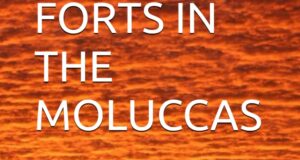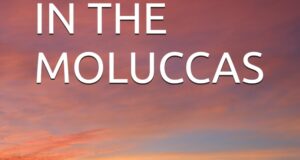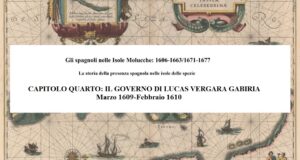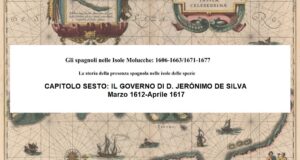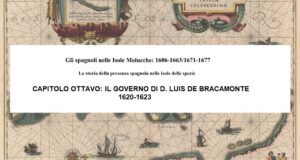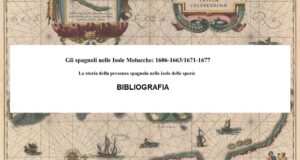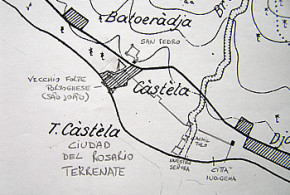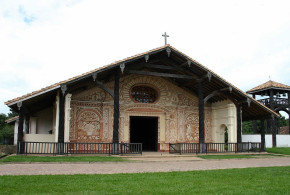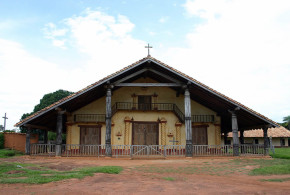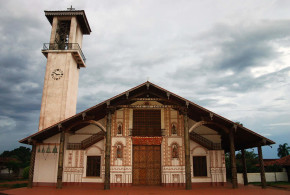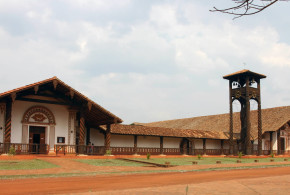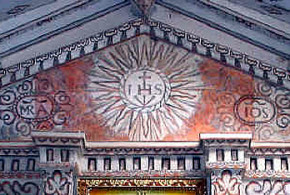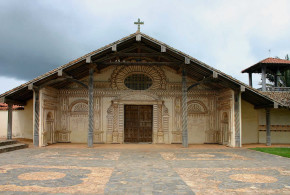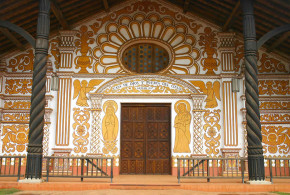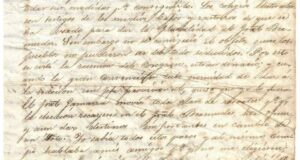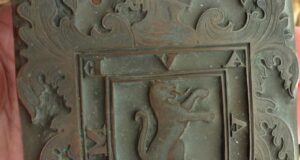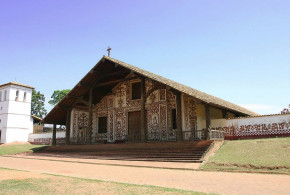This post is also available in:
![]() Italiano
Italiano
The Spaniards in the Moluccas: 1606-1663/1671-1677. The history of the Spanish presence in the spice islands
Written by Marco Ramerini. 2005-2020/23
THE ARRIVAL OF CRISTÓBAL DE AZCUETA MENCHACA IN TERNATE
The new governor of Ternate, the “mestre de campo” Cristóbal de Azcueta Menchaca, was appointed by the governor of the Philippines Don Juan de Silva.1 On February 4, 1610 we find Azcueta still in Arevalo about to leave for Ternate. 2 He arrived in Ternate in February 1610 in command of a small squadron of boats. 4 Franciscan friars were also part of the expedition. Probably the captain and sergeant major Fernando de Ayala also arrived with Azqueta. 3
When they arrived in sight of the island of Ternate, only 6 leagues from the port of Ternate, the Spanish boats sighted an imposing Dutch squadron. The Spanish ships fled and most of them managed the same night under cover of darkness to reach Ternate, but the Dutch managed to capture a galley and a champan with their crews. On this occasion the Dutch captured about 60-70 people among whom was an infantry captain, a “contador” of the royal company, an ensign and two religious.4 In this period, on 2 February 1610 to be precise, the Jesuit father Gabriel Rengifo da Cruz died in Ternate. He had arrived in Ternate in 1606 and had preached among other things in the Moro area on the island of Halmahera.5
One of Azcueta’s first actions at Ternate was an attack on a Dutch vessel. On Azcueta’s orders, the sergeant major Fernando de Ayala, who had recently arrived in Ternate with the new “socorro”, attacked with the galley San Xpoual (San Cristobal, i.e. the “captain” galley), together with 50 soldiers and Captain Juan de Espinosa y Sayas, a Dutch Patak, the Masambique (Maçanbique), armed with 20 pieces of artillery and loaded with provisions, which was anchored in the port of Malayo, the Dutch vessel, after a hard battle lasting an hour, was burnt and sank, everything happened within sight of the walls of the Dutch fort of Malayo, some Dutch prisoners were also taken in the battle. 6 Juan de la Umbria also took part in this assault and was seriously wounded in the right thigh. 7
Azqueta, shortly after his arrival in Ternate, became aware of the chronic lack of men and equipment. So he sent Pero de Hermua to Manila to ask for urgent help. Hermua returned to Ternate on August 3, 1610 with a ship loaded with food and ammunition. 8
THE LIBERATION OF VAN CAERDEN
Another of the acts that the “mestre de campo” Christobal de Axqueta did as soon as he arrived in Ternate was to negotiate the release of Admiral van Caerden with the Dutch. The Dutch admiral was freed on March 16, 1610, in exchange for some Spanish prisoners (mostly the crews of the two boats captured upon Azcueta’s arrival in Ternate, and also the men captured in the Bachian fort) and a sum of money.
There are conflicting testimonies as to the number of prisoners released and the amount of ransom paid by the Dutch for van Caerden, but according to Don Juan de Silva and also according to Heredia’s “Meritos”, there were 50 Spanish soldiers and sailors and 30 Indians, “gastadores” and officers released in the exchange, as well as 6,000 pesos in cash. 9 According to other sources such as the report of Father Gregorio Lopez, for the admiral’s ransom, the Dutch paid 80,000 pesos as an advance in 1609, then at the time of the ransom they paid another 6,000 pesos in addition to the frigate and all its cargo, and also freed 52 Spaniards and 100 native allies of the Spaniards. 10
In one of his reports dated June 1610, van Caerden judged invincible the fortifications of the Spanish city. Therefore the works undertaken by the Spaniards must have already been well advanced. He also informs us of the construction of the fort of Don Jil, which he strangely calls Nouckenorre, it had three stone bastions and was located between Malayo and the Spanish city.
In the same letter he informs the administrators of the VOC of the scarce knowledge that the Dutch had of the island of Tidore, in particular they had no information of the defenses of the capital of the island, while they were informed of a Spanish fort in Marieco and of three small posts fortified in the island of Halmahera: Solo (=Tolo), Payjay and Taffongo. The Spanish forces amounted, according to the Dutch admiral, to about 500 Spanish soldiers in addition to many natives of the Philippines who worked on the construction of the fortifications. For the connections between their garrisons the Spaniards maintained 2 boats, a 18-bank galley and a galliot. 11
VAN CAERDEN’S NEW CATCH
On 1512 July 1610, as already mentioned above, the Dutch admiral van Caerden was again captured by the Spaniards near the island of Tidore, in fact a Spanish galley, the San Christobal (San Xpoual), led by Captain Pedro de Avellaneda13 and on which there were 50 Spaniards, he had, for three hours, a hard naval clash with the “patacco”14 of van Caerden who embarked besides him 25 Dutch. The battle ended with the Spanish victory and with the new capture of the admiral.
Some Spaniards were injured in the clash, including Pedro de Avellaneda himself, “cauo superior de las ysla y fuezas de Tidore”, who died a few days later due to the wounds suffered during this clash. On August 23, 1610, Pedro de Hermua, who had just arrived from Manila, was appointed by Azcueta, in place of the deceased Pedro de Avellaneda, in charge of the island and the fortresses of Tidore and the garrisons of Payáy and Tafongo. 15
Paulus van Caerden (Pablos Brancaerden in the Spanish), was in command of all Dutch troops present in the Moluccas and Banda Islands. After his new capture the Dutch position, according to the enthusiastic reports of the Spaniards, seems to be weakening, in fact the Spaniards say that only a “nauio” and a patacco remain with the Dutch in all their possessions, from Banda to the Moluccas. Furthermore, there was little hope that reinforcements could reach the Dutch in the following months.
According to some papers found after the capture of van Caerden, the income that the possession of the Moluccas gave to the Dutch amounted to more than 4 million pesos a year. Despite the new capture of the admiral and the Spanish hopes, the Dutch position is still very solid, mainly thanks to the alliance with Ternate where a younger son of the old Said Berkat had been installed as sultan.
The Spaniards, on the other hand, had no allies among the Ternatese. Their only and faithful ally was the king of Tidore, where, however, the majority of the population was hostile to the Spaniards. To try to undermine the compactness of Ternatese, the governor of the Philippines Juan de Silva thought of bringing the old sultan Said Berkat back to Ternate, on the occasion of the great expedition that he was planning to make in Ternate. This was supposed to contribute, according to his plans, to dividing the Ternatese and making at least part of the population pass over to the Spanish side. 16
The captured Dutch “patacco” with van Caerden was sent, on July 30, 1610, to Manila where he arrived in August 1610. In Ternate, Juan de Azevedo, received the task of guarding the Dutch general van Caerden. 17 In April 1612 Caerden was still a prisoner of the Spanish in the fortress of Ternate.18 Paulus van Caerden (Blancardo for the Spanish), was later taken to Manila where he remained until his death.19 Van Caerden appears to have left Ternate for Manila on May 24, 1612. 20 The Spanish demanded for Caerden’s ransom 40,000 reals from eight. 21
The confirmation that Caerden died in Manila comes from a document written in Manila on September 17, 1618, which mentions the ‘general Pablo Brancaerden que murio en esta ciudad’. 22
THE FRANCISCANS IN THE MOLUCCAS
In 1610 the Franciscans moved their convent outside the city walls. In fact, thanks to the interest of the new “mestre de campo” of Ternate, Cristóbal de Azcueta Menchaca, who bought a house (“buenas de tabla”) at his own expense with a piece of land that belonged to a Spaniard. The house was located outside the walls of the city of Ternate, and here the Franciscans moved their convent, named S. Antonio de Padua, and built their church on the plot of land. After these improvements, in addition to the church and convent, all of wood, the friars also had a large vegetable garden and continued to take care of the old hospital. The Franciscans present in Ternate this year were six: Br. Diego de Santa Maria (who took care of the hospital), Fr. Juan del Caño (appointed president of the convent), Br. Antonio de Santa Ana, Br. Sebastian de S. José, Br. Cristobal Gomez and Br. Alonso Guerrero. 23
The Franciscan friar Sebastián de San José had been nominated, in 1609, provincial commissioner for the Moluccas. In June 1610, he visited the island of Macasar (Manados), where he made many conversions. On the beach at the mouth of the Rio Cauripa, Fr. Sebastian founded a small wooden chapel and died, in fact he was killed on June 18, 1610 during an attack by the natives. His traveling companion, the lay brother friar Antonio de Santa Ana, was captured by the same natives, deported to the island of Tagolanda and killed a few days later, on 28 (24 according to Trinidade) June 1610. 24
THE JESUITS IN THE MOLUCCAS
In October 1610 a group of 5 Jesuits arrived from Malacca (João Baptista, Andrea Simi, Giambattista Scalamonti, Manuel Leitão and Jorge da Fonseca) destined for the mission of the Moluccas, they were led by Fr. João Baptista. 25 Father Jorge da Fonseca was immediately assigned to the spiritual care of the Spanish garrison of Tidore. 26 He describes the island of Tidore in his letter of April 8, 1612: “que hé huma ilha quatro legoas de Ternate, de mouros amigos nossos, onde há alguns christãos da terra, portuguezes casados e hum presidio de soldados hespanhoes, que todo este tempo atrás avia estado sem padre por falta de sarcedotes”.27 The Jesuit mission of Tidore remained without a father until the end of 1610, in the continuation of his letter Fonseca again describes Tidore, this time making mention of two Spanish garrisons present on the island (according to Jacobs’ note [Doc. Mal. III p 224 note 45] the two garrisons were the old Portuguese fort, near Soasio and the fort of Marieko on the west coast). 28
In Ternate, thanks also to the goodwill of the governor Cristobal de Azcueta Menchaca, the Jesuits founded the “confraria do Santissimo Sacramento”. 29 The Jesuits took care not only of the conversion of the natives but also of the spiritual care of the crews of the galleys and of the soldiers in the garrisons, regularly visiting the Spanish garrisons. Captain D. Juan de Castro Verde y Ayala bears witness to this, informing us that when he was captain of a fort on the “frontera de Malayo” (most likely Don Jil or San Pedro y San Pablo) the fathers came to say Mass every public holiday. Captain D. Diego de Quiñones y Arguelles (captain of the forts of San Pedro y San Pablo in Ternate and then of the “fuerça” of Tomañira in Tidore) also tells us in one of his testimonies that the fathers often visited the garrisons and sometimes stopped even many days to confess and say Mass.30
THE SPANISH FORTIFICATIONS AT TERNATE AND TIDORE IN 1610
A Dutch report written in 1610 gives us a description of the Spanish-held fortifications on the islands of Ternate and Tidore: On the island of Ternate, the Spaniards are in possession of the great city of Gammelama, which is called Nuestra Signora del Rosario. Between this city and Malaya, there is another fort called “Pedro ende Paulo”. On Tidore there are three places, the first is a large city where the king of the island resides it has a fortification on a high hill, called Taroula, this fortification has 10 cannons and a garrison consisting of 50 Spaniards and 8-10 Filipinos . The second place is the old Portuguese fort, which in 1605 was conquered by Cornelis Bastiaensz, but which was now in the possession of the Spanish, 2 cannons were mounted in the fort and the garrison consisted of 13 Spanish soldiers. The third place is the small town of Marieco, which is located opposite the town of Nuestra Signora del Rosario, some Tidorese live here and the Spanish have surrounded the place with two bastions, where 14 Spanish soldiers and two cannons are stationed. 31
According to some documents it was during the government of Azcueta that the fort of Don Gil was built about halfway between Ternate and Malayo. But as we saw in the fourth chapter, the construction of the fort is due to Lucas Vergara. Azcueta probably finished it. The fortress guarded the path and pass that connected the two enemy positions. Near the city of Ternate, Azcueta built the fort of S. Pablo on a hill (“padrastro”) which dominates it. Then he built the wall around the city of lime and stone, fortifying several bastions among which one called San Juan, which controlled the beach on one side and the hill on the other. Among his works is also the restoration of the hospital of the Franciscans. 32
In 1611, Juan de Azevedo, had the task of commander of the troops of the king of Tidore, always in the same year he received the task of controlling the mouth of an enemy port so that no aid would reach the enemies during this assignment he fought with two boats from Ternate managing to capture one and run the other aground. 33
THE EXPEDITION OF JUAN DE SILVA
The governor of the Philippines Don Juan de Silva had been preparing a large expedition for some time to eliminate the Dutch presence in the seas of Southeast Asia once and for all. For this purpose he had thought of building three large boats in the Philippines specially equipped for shipping to the Moluccas. The viceroy of Portuguese India, Ruy Lorenzo de Tavora, guaranteed his support for the planned expedition and offered the participation of 7 large galleons which had been sent, via Malacca, to Macao under the command of Don Diego de Vasconcellos. The commander of the galleon squadron Don Diego de Vasconcellos also wrote from Malacca to de Silva expressing his willingness to participate in the expedition, 34 this offer from the Portuguese side rendered useless the construction of the three large boats designed by de Silva which then remained only in the projects.
Having received news that the Portuguese galleons promised by the Viceroy were anchored in the port of Macao, Don Juan de Silva sent a delegation to Macao (commanded by Juan Juarez Gallinato) to invite the flotilla commander, Don Diego de Vasconcellos, to join him and thus carry out the orders given by the viceroy. Gallinato set sail from Cavite in September 1610, reached Macao and had several meetings with Vasconcellos which the bishop of Macao also attended.
Vasconcellos initially showed himself willing to participate in the enterprise, but then when Gallinato proposed the immediate need to leave for the expedition, Vasconcellos, in defiance of the orders received from the Viceroy, despite repeated appeals from the Spaniards, and against the advice of the admiral of his fleet and of the soldiers embarked, he refused to take part in the expedition, preferring to use his army for personal gain by trading between Goa and Macao. De Silva had provided Gallinato with money to be able to ensure sufficient food for the Portuguese army and Gallinato also had carte blanche to use de Silva’s personal money to soften the reluctant Portuguese commander. De Silva, who had also received a favorable report from the governor of the Moluccas, Azcueta, on the lack of consistency of the Dutch forces present in the islands, also sent this report to Macao hoping thus to move the Portuguese commander, but even this last attempt did not had the desired effects. 35
De Silva’s plans were to leave for Ternate, by the end of November 1610, once the Portuguese galleons had arrived, in order to reach Ternate at the beginning of January 1611 and therefore be able to close the matter with the Dutch by the beginning of May in order to anticipate a possible arrival of reinforcements for the Dutch troops. In addition to the galleons he hoped would arrive from Macao, he had in Manila, as “capitana” and “almiranta” 2 large ships captured from the Dutch, and then the ship “Espiritu Santo” and the ship “San Andres”, as well as two “pataccos” and three galleys. A last project of de Silva was to bring the sultan of Ternate Said Berkat with him in the expedition together with a large part of his retinue, the governor’s intentions were to bring the majority of the population of Ternate to the Spanish side, and once eliminated the Dutch leave the old sultan on the throne as a vassal of the king of Spain.
In 1611, D. Juan de Silva, having received the news of Vasconcellos’ refusal, nevertheless decided to leave, trying to take advantage of the moment of relative weakness of the Dutch forces. De Silva’s motivations are clearly indicated in one of his letters, in which he explains how this is the propitious year, even if by waiting a year the Spaniards could probably have had more forces for the expedition, but surely in the meantime the Dutch would have fortified themselves more. 36
THE OLD SULTAN OF TERNATE PARTICIPATES IN THE EXPEDITION
Also taking part in the Spanish expedition were the old sultan of Ternate, Said Berkat, held until then in exile in Manila, his son, Prince Sulampe together with the principal cachiles who were held with him in exile in Manila. The hope of the Spanish governor was to be able to balance the excessive Dutch power with the return of the old sultan, who had promised to help the Spanish and with his presence to bring the majority of the inhabitants of Ternate to the Spanish side. Taking part in the expedition were 2 large boats captured the year before from the Dutch, another ship (called Espiritu Santo), 3 old boats (San Elifonso, Santiago and San Pedro y San Pablo) and 2 galleys with about 2,000 soldiers on board and sailors.37 With the position of admiral Pedro de Heredia also returned to Ternate with this expedition, he was appointed by Juan de Silva sergeant major of the garrisons of the Moluccas. 38
Despite the unfavorable opinion of most of the Real Audiencia of Manila39, the governor wanted to captain the expedition himself. His direct participation was repeatedly requested expressly by the Sultan of Ternate, who said that without de Silva’s presence he could not keep his promise. This seems to have been the main reason de Silva took a direct part in the expedition.40
The expedition was a failure for the Spanish. The attempt to install the old sultan on the throne of Ternate soon foundered due to the aversion of the population, as a counter move the Dutch had installed on the throne of the sultanate, as early as 1610, another son of the old sultan, Modafar.41
However, the failure of the expedition is largely due to de Silva’s renunciation, it seems that at the crucial moment, upon his arrival in Ternate, he stalled seeking agreements with the Ternatese, instead of immediately attacking the Dutch fortress of Malayo, which was in bad shape and with few men to defend it. Estaban de Alcazar was sent to Malayo and was commissioned by de Silva to deliver a letter (where the ransom of prisoners captured by the Spaniards in Manila was dealt with) to the Dutch in the fort of Malayo so as to have the opportunity to see and study from nearby the defenses set up in the fort by the Dutch. 42
His indecision allowed the Dutch and their allies to improve the defenses of the fort and to receive soldiers and aid from the Dutch garrison of the fort “Jacome” on the island of Makian.43 When he decided to attack the fort, he judged it too well defended and did not dare to attack it. Instead, it was decided to send a caracoa of the King of Tidore to Ambon to observe the movements of the Dutch, and when the governor learned that 5 Dutch galleons were present in Ambon, he inexplicably ordered the ships that had accompanied him to return to Manila.44 The governor remained in Ternate with all the infantry troops, the “San Buenaventura” patrol and the two galleys.
THE CONSTRUCTION OF A SPANISH FORT AT TOLOCO
As the only activity of some weight, the place of Toloco was occupied, near Malayo, and the Spaniards built a fort of “faxina”. 45 According to Azcueta’s testimony it seems that an attempt was made by occupying Toluco and building a fort there: “auiendo acordado el Señor D. Juan de Silva …….. tomar y fortificar al puesto de Toloco serca de Malayo”), in 1611, the governor of the Philippines D. Juan de Silva, decided to occupy and fortify the post of Toloco near Malayo (“serca de Malayo”), for this he ordered that three companies were to occupy the place. At the head of the three companies was appointed Fernando Centeno Maldonado who with his company and together with those commanded by Andres Hinete and Pedro Çapata began to fortify the post “acudio ala fortificacion del por cauo de tres compañias de infanteria españolas”.
However, it seems that the Spanish did not complete the work and the occupation of the fort, but this attempt still served as an alarm bell for the Dutch who built the fort of Toloco a few months later. This testimony shifts the construction, or occupation, by the Dutch of the fort of Toloco, which is generally dated 1610, by one year. 46
Another interesting reference to the construction of a Spanish fort in Toloco is made in another Spanish document, the “Meritos” of Fernando de Ayala, where it is mentioned that this captain and sergeant major on the occasion of Juan de Silva’s expedition to Ternate built the fort of San Juan de Toloco: “con mucho trauaxo y rriesgo hiço el fuerte de San Juan de Toloco”. 47
A more detailed testimony of the effective construction of a fort, by the Spaniards, in Toloco is given to us in Fernando de Ayala’s “Meritos y servicios”, here in fact it is clearly indicated that Fernando de Ayala on the orders of the governor Don Juan de Silva built the fort called San Juan de Toloco in the vicinity of Malayo: “Por horden del diho Cap.n Gen.l (don Juan de Silva) paso de otra vanda de Malayo (que ?) llaman Toloco muy cerca dellas fuercas del enemigo que es a tiro de cañon y fabrico un fuerte de faxina con grandisimo travajo e riesgo para tener mas oprimido y sitiado al diho enemigo” “hizo un fuerte llamado de San Juan de Toloco çerca del de Malayo” “por mandado del diho Gouer.or. (don Juan de Silva) hizo un fuerte llamado San Joan de Toloco que está a tiro de cañon della fuerça de Malayo”.
Don Fernando Centeno Maldonado, in his testimony specifies that the expedition led by Ayala was made up of 5 companies and he took part in the expedition himself. From Toloco then sailed the expedition of de Silva directed to Halmahera and with which the forts of Jailolo and Sabugo were captured. 48
Another testimony in the “Meritos” of Pedro de Heredia, even if Toloco is not explicitly mentioned, most likely refers to this episode. Indeed here is cited an act performed by Heredia during Juan de Silva’s expedition of 1611, on de Silva’s orders, he landed at the head of 400 men a quarter of a league from the Dutch fort “tomo puerto e se fortifico alli”. 49 The Spanish probably abandoned the fort shortly after its construction, almost certainly as early as de Silva’s departure for Halmahera.
THE ATTACK ON JAILOLO AND SABUGO
De Silva then decided to attack two secondary objectives such as the forts of Jailolo and Sabugo on the western coast of Halmahera. 50 The two villages were conquered by Spanish troops. But in these battles the Spaniards apparently lost 300 men.51 The death toll that the Spaniards paid in the conquest of Sabugo was particularly heavy. The village of Jilolo, on the other hand, appears to have fallen under Spanish control almost without a fight after an agreement with the local population52, decisive, in this negotiation, seems to have been the presence of the prince of Ternate accompanied by Esteban de Alcazar “y fue a Gilolo con el Principe de Terrenate al trato que con el se tuuo, y por su medio se entregô”. 53
In the expedition that led to the conquest of Sabugo, 10 captains with their companies took part together with the “mestre de campo” Azcueta, who attacked the stronghold by land. Among these was also Captain Pedro de Hermua who distinguished himself, after observing the fortifications, at the head of a platoon of 50 “picas” with which he attacked and crossed the river which served as a moat. Thanks also to this action, the enemies were then forced to surrender, among the prisoners there were also some Dutch soldiers, Hermua was wounded in the thigh by a musket shot in the clash. After this episode Hermua returned to govern the Spanish forts of the island of Tidore. 54
Another captain, Juan de Espinosa y Sayas, also distinguished himself in the assault on Sabugo. Sayas was entrusted with all the troops equipped with muskets and 25 pikes made up of reformed captains and ensigns with whom Governor Azcueta had also arrived, who gave orders to Sayas to recognize and attack a “fuerte dificultoso” that they had found during the march towards Sabugo. Sayas succeeded well in his task, the Spaniards thanks to his action managed to cross a river that stood between them and Sabugo, and fighting they advanced up to the Dutch fort, conquering it together with the village of Sabugo. 55 Juan de Azevedo also participated in the conquest of Sabugo as a captain in command of 40 “picas”. 56
After the conquest of Sabugo, Azcueta appointed, on April 9, 1611, Juan de Espinosa y Zayas “cauo superior” of the “fuerza de Sabugo y su districto”, his task was to fortify the village and establish good relations with the local population that he wanted to submit to the Spaniards. 57 To garrison Sabugo and to proceed expeditiously with the improvement of its fortifications, three companies of Spanish infantry and two companies of Pampanga infantry were left under the command of Juan de Espinosa y Zayas. In addition to reinforcing the existing fortifications, the Spaniards built a new fort in Sabugo located at the “boca del rio”. 58
THE RESULTS OF DE SILVA’S EXPEDITION
These were the only two successes of D. Juan de Silva’s expedition which had aroused great hopes among the Spaniards present in Ternate.59 The expedition, which had set itself the goal of eliminating the Dutch presence in the spice islands, ended in a colossal fiasco that cost the state’s meager coffers over 200,000 pesos.60
From a practical point of view, however, the conquest of the two strongholds was of great importance, because the possession of Sabugo and Jilolo ensured the Spaniards an important source of food for the garrisons and at the same time deprived the Dutch of this source of food.
Without a doubt, the non-arrival of the 7 galleons promised by the viceroy was the main cause of the failure of de Silva’s expedition. Most likely de Silva began the adventure disheartened by the defection of the Portuguese galleons. Another reason was that the governor trusted the promises too much (“que nunca complio lo que prometio”61) in the promises of the sultan of Ternate to bring the great majority of the local population to the Spanish side with his arrival, it seems in fact that the sultan played a double game and instead of favoring an agreement has stalled. Another cause was the reluctance to quick action shown by de Silva at the crucial moment of arrival, when the Malayo Dutch were not yet prepared for a siege. The whole thing seems to have been aggravated by the poor health of the governor.62 All these causes led to the failure of the entire expedition.
Juan de Silva’s expedition lasted only 4 months. Juan de Silva had probably arrived in Ternate in February 1611 63 and left again in May 1611. 64
THE DUTCH FLEET OF PIETER BOTH
A few months after the governor’s departure for Manila, at the end of September 1611, a fleet of Dutch ships65 arrived in the waters of the Moluccas, it was the fleet of Pieter Both. These boats headed for the island of Halmahera where they tried to bring the inhabitants of Jailolo (Tyrol) and Sabugo to their side. The population of Jailolo (Geillollo) remained faithful to the Spanish, but that of Sabugo agreed with the Dutch and rebelled, but despite this, the Spanish did not abandon the “posto e forte de Sabugo”.66 Sabugo, was important because sago was produced there, “que es el pan de aquella tierra”67, very important food for the sustenance of the garrisons of Tidore and Ternate and of the local population.
The Dutch of this fleet, with the help of the inhabitants of Ternate, besieged the Spanish fort of Jailolo, which was commanded by Fernando Centeno Maldonado, but the prompt intervention of the Spanish rescue forces, a galley and some “caracoas”, led by Fernando de Ayala with his company and that of Pedro Çapata (Zapata), managed, after a hard battle against the enemy “caracoas”, to rout the Dutch and to bring reinforcements and ammunition to the fort.
The Spanish troops then moved to the fort of Sabugo, which was commanded by don Juan de Espinosa y Sayas, and which was also under close siege by a fleet composed of two Dutch ships and many Ternatese “caracoas”. Here, due to the tight siege, the Spaniards, with their boats, could not bring help to the besieged garrison, so the commander of the expedition Fernando de Ayala landed the troops at Jailolo and by land they reached Sabugo where they managed to bring the help of men and munitions, these two actions forced the Dutch to lift the siege on the two forts. The population of Sabugo later submitted again to the Spanish. 68
In September 1611, the Dutch captured the only galley the Spanish had in Ternate, this loss was a serious blow to the Spanish. 69 The galley was probably lost during the clashes that took place in Jilolo or Sabugo in September or October 1611, in fact Geronimo de Silva also indicates that in April 1612 the Dutch had captured the Spanish galley since more than 6 months. 70
A TRADE FACTORY FOR THE SPICE TRADE
Pedro de Baeza, in November 1611, was appointed by the king, factor of Ternate, he had the task of developing the production of cloves and of administering the royal properties of Ternate. According to the King, the main purpose of this farm was to make the Philippines and the Moluccas financially independent, thus avoiding money remittances from New Spain to put the island’s budgets back on track.71
THE RIVALRY BETWEEN SPAIN AND PORTUGAL
In the years 1610-1611 there were several discussions in Spain as to which of the two crowns of Portugal and Spain should have rights to the Maluku Islands. The Portuguese demanded the return of the islands due to their past rule, while the Spanish argued that it was better to leave them under Spanish control because it was easier to send troops and supplies from the Philippines than from Malacca and Goa. However, the islands remained under Spanish control. As far as the trade in cloves was concerned, the Council of the Indies expressed the opinion that it should be managed by the Portuguese, because it was more economically convenient to sell the cloves in the Indies of Portugal, however to carry out the negotiation of the cloves had to be Spanish royal officers. 72
Notes on Cristóbal de Azcueta Menchaca:
Azcueta served in the Philippine Islands and the Moluccas for 36 years, from 1575 until 1612, the year of his death during a shipwreck between Manila and Macao, when he was on his way to India where he had to negotiate with the viceroy the preparation of a joint expedition against the Dutch.
During his services in the Philippines he was appointed ensign, alcaide, galley captain, ship captain, army admiral, infantry captain, regidor of the city of Manila, sergeant major, he then participated in the great expedition of 1606 which led to the conquest of Ternate with the rank of senior sergeant and admiral of the Moluccan Army.
He was familiar with things in Ternate as he had already been there twice before this expedition. During the attack on the fortress (1606) he was among the first to land, he was also responsible for the rapid ground movements of the Spanish troops, which in less than an hour after the landing were within sight of the enemy walls. He helped the advance troops to take possession of an eminence facing the Cachiltulo Bulwark, and was among those who attacked and captured the same Bulwark. In 1610 he was appointed governor of Ternate where he remained until 1612. 73
In the report on the merits of Diego de Azcueta y Menchaca, son of Cristóbal de Azcueta Menchaca, it is indicated that his father was appointed general of the Ternate galleys and for a second time “mestre de campo” of the “gente de guerra della”. 74
INDEX
1: The first contacts of the Spaniards with the Moluccas
2: The conquest of Ternate
3: The government of Juan de Esquivel, May 1606-March 1609
4: The government of Lucas de Vergara Gabiria (acting the functions), March 1609-February 1610
5: The government of Cristóbal de Azcueta Menchaca (who performs the duties), February 1610-March 1612
6: The government of D. Jerónimo de Silva, March 1612-April 1617
7: The government of Lucas de Vergara (Bergara) Gabiria (second term), April 1617-February 1620
8: The government of D. Luis de Bracamonte (who performs the functions), February 1620-1623
9: The government of Pedro de Heredia, 1623-1636
10: The government of D. Pedro Muñoz de Carmona y Mendiola (who performs the functions), March (?) 1636-January 1640
11: The last Spanish governors of the Moluccas
12: Bibliography
NOTES:
1 (AGI “Meritos: Diego de Azcueta y Menchaca, 1632” Indiferente, 111, N.134)
2 See: (“Informaciones: Jerónimo Enriquez Sotelo. Informaciones de oficio y parte: Jerónimo Enriquez Sotelo, general. Información con parecer. [f] 1640” Filipinas,61,N.20 bl. 1 f. 97-98)
3 (AGI: “Méritos y servicios Fernando de Ayala Filipinas, 23-07-1622” Patronato 53 R.25)
4 (Doc. Mal. III p. 180 Doc. n°48A, note 2) (Perez “Malucas y Celebes” pp. 689-690) (AGI “Meritos: Diego de Azcueta y Menchaca, 1632” Indiferente, 111, N.134) (AGI: “Parecer de la Audiencia sobre Pedro de Heredia, 20-07-1612” Filipinas,20,R.6,N.50) (AGI: “Meritos Pedro de Heredia, 22-09-1628” Indiferente,111,N.78)
5 (Doc. Mal. III p. 175 Doc. n°48, note 3)
6 (AGI: “Meritos, Fernando de Ayala, 27-07-1643 Indiferente,112,N.47) (AGI: “Méritos y servicios Fernando de Ayala Filipinas, 23-07-1622” Patronato 53 R.25) (AGI: “Confirmación de encomienda de Bongol, etc. Juan de Espinosa y Zayas. 10-10-1618” Filipinas,47,N.11)
7 (AGI: “Confirmación de encomienda de Marinduque, etc. Juan de la Umbria. 02-10-1623” Filipinas,47,N.60) (AGI: “Confirmación de encomienda de Bondoc. Juan de la Umbria. 02-10-1630” Filipinas,48,N.41)
8 (AGI: “Confirmación de encomienda de Laglag, etc Pedro de Hermua, 13-07-1619” Filipinas,47,N.28)
9 (AGI: “Carta de Juan de Silva sobre los holandeses y el Maluco. Cavite, 05-09-1610” Filipinas,20,R.4,N.38). (AGI: “Meritos Pedro de Heredia, 22-09-1628” Indiferente,111,N.78)
10 See “Extract from the Relation of events in the Filipinas during the years 1609 and 1610, by father Gregorio Lopez, 1 luglio 1610” In Blair vol. 17 p. 140) (According Fr. Gregorio de S. Esteban the ransom amount was only 5,000 pesos. (Perez “Malucas y Celebes” p. 690 nota 1))
11 (de Booy “De derde reis van de VOC naar Oost-Indië onder het beleid van admiraal Paulus van Caerden uitgezeild in 1606” vol. II p. 239 “Copie van het scrijven van Paulus van Caerden aan de bewindhebbers dd. 17 juni 1610”)
12 (More likely on the 13th?, see van Veen-Klijn “A guide to the sources…” p. 117)
13 According to Fr. Gregorio de S. Esteban he was the captain “de las fuerzas” of Tidore. (Perez “Malucas y Celebes” p. 690 nota 1)
14 The “patacco” of Caerden was called “Buena Esperanza” ie “Goede Hoop”. (Perez “Malucas y Celebes” p. 690 nota 1) (AGI “Trasunto de la relación de los papeles que se hallaron en el navio que se tomó al el enemigo…” In: “Cartas del Virrey Luis de Velasco (el hijo) 1607-1611” Mexico 28, N2
15 (AGI: “Confirmación de encomienda de Laglag, etc Pedro de Hermua, 13-07-1619” Filipinas,47,N.28) (AGI: “Carta de Juan de Silva sobre los holandeses y el Maluco. Cavite, 05-09-1610” Filipinas,20,R.4,N.38)
16 (AGI: “Carta de Juan de Silva sobre los holandeses y el Maluco. Cavite, 05-09-1610” Filipinas,20,R.4,N.38) (See: “Letter by Don Juan de Silva to king Felipe III, 9 september 1610” in Blair vol. 17 p. 145-149) (Perez “Malucas y Celebes” p. 690 nota 1)
17 (AGI: “Meritos, Juan de Acevedo 1625” Indiferente,111,N.56)
18 (Doc. Mal. III pp. 212-213 Doc. n°59)
19 (Montero y Vidal p. 155)
20 (“Generale Missiven” vol. I pp. 8-15)
21 (See van Veen “A guide to the sources…” p. 117)
22 “Confirmación de encomienda de Albay, etc. Expediente de confirmación de las encomiendas de Albay y Canaman en Camarines y Catanduanes, a Gregorio de Vidaña. Resuelto, [f] 1620-10-21” FILIPINAS,47,N.38 blocco 2 foglio 26
23 (See: “Entrada de la seraphica religion de nuestro P. S. Francisco en las Islas Filipinas” pp. 45-46, manuscript of 1649, published in: Rentana, W. E. “Archivo del bibliófilo filipino” Tomo 1) (“Early Franciscan Missions” In: Blair, E. H. e Robertson, J. A. “The Philippine Islands, 1493-1898” vol. 35 p. 306) (Pérez p. 684 nota 1 e pp. 691-692)
24 (“Early Franciscan missions” In: Blair, E. H. e Robertson, J. A. “The Philippine Islands, 1493-1898” vol. 35 pp. 291-292 note 75 e 76) (Perez “Malucas y Celebes” pp. 692-694 e pp. 204-209) (Trinidade “Conquista espiritual do Oriente” vol. III pp. 484-486)
25 (Doc. Mal. III p.216 Doc. n°59) e (Doc. Mal. III p. 27*)
26 (Doc. Mal. III p. 192 Doc. 53) e (Doc. Mal. III p. 24*)
27 (Doc. Mal. III p. 217-218 Doc. n°59)
28 (Doc. Mal. III p. 224 Doc. n°59)
29 (Doc. Mal. III p. 219 Doc. n°59) This brotherhood was already present in Ternate at the time of the Portuguese (Doc. Mal. I p. 382 Doc. 116 nota 3)
30 (Colin-Pastells “Labor Evangelica” vol. III pp. 569-571 note n°1)
31 (Voyage of Admiral Pieter W. Verhoeven, written in 1610 p. 112)
32 (Gregorio de S. Esteban “Historia de las Malucas” p. 50 this passage is reported in: Perez “Malucas y Celebes” p. 214)
33 (AGI: “Meritos, Juan de Acevedo, 1625” Indiferente,111,N.56)
34 (Colin-Pastells “Labor Evangelica” vol. III p. 301 nota n°1) (AGI: “Carta de Juan de Silva sobre los holandeses y el Maluco. Cavite, 05-09-1610” Filipinas,20,R.4,N.38)
35For the entire course of the negotiations with Vasconcellos, see the testimonies reported in: (Colin-Pastells “Labor Evangelica” vol. III pp. 297-309 nota n°1) (Pastells “Historia general de Filipinas” tomo VI (1608-1618) pp. clviii-clxiii AGI 67-6-29) (AGI: “Carta de Juan de Silva sobre los holandeses y el Maluco. Cavite, 05-09-1610” Filipinas,20,R.4,N.38)
36 (AGI: “Carta de Juan de Silva sobre los holandeses y el Maluco. Cavite, 05-09-1610” Filipinas,20,R.4,N.38)
37 (Colin-Pastells “Labor Evangelica” vol. III p. 299 nota n°1) There were instead 6 ships, 3 triremes, “celoces fere decem” and many sampams on these ships were embarked about 2,000 Spanish and Filipino soldiers, according to (Doc. Mal. III p. 194 Doc. n°54). According to Father Francisco Colin, the expedition included 6 ships, 2 galleys, 8 frigates and many other small boats on board which were over 2,000 Spaniards and Indians, with them, in addition to other religious, also the Jesuit Father Angelo Harmano (Armano), a native of Lucca in Tuscany. (Colin “Labor Evangelica” vol III pp. 262-263, 277-278)
38 (AGI: “Parecer de la Audiencia sobre Pedro de Heredia, 20-07-1612” Filipinas,20,R.6,N.50)
39 Those in favor of the expedition were only three or four “corregidores” all the others advised the governor, given the weakness of the army, not to expose himself directly, but to send soldiers and ammunition in large numbers to Azcueta so that in case of failure the Spaniards did not lose their reputation with the natives. (Colin-Pastells “Labor Evangelica” vol. III p. 263 nota n°1)
40 This also according to the opinion of Cristobal de Sequeira: “…entiende este testigo por cierto que si no fuera por la promessa que el rrey de Terrenate hizo a Su Señoria no fuera a el Maluco…” (Colin-Pastells “Labor Evangelica” vol. III p. 301 nota n°1) Anche Juan Ronquillo da lo stesso parere (Colin-Pastells “Labor Evangelica” vol. III p. 302 nota n°1)
41 (Doc. Mal. III p. 197 Doc. n°55)
42 (AGI: “Parecer de la Audiencia sobre Esteban de Alcazar, 07-08-1615” Filipinas,20,R.9,N.57).
43 The soldiers sent from Makian were led by the same commander of the fortress “Jacome” of Makian, the captain “Escoto”.
44 Even in his statement, Admiral Rodrigo de Guillestigui, increases the dose by saying that the departure of the ships was so hasty that they did not even finish unloading the goods and food they were carrying for the garrisons of the Moluccas. (Colin-Pastells “Labor Evangelica” vol. III p. 263 nota n°1; AGI Filipinas: 67-6-20)
45 (AGI: “Informaciones Fernando Centeno Maldonado, 1615” Filipinas,60,N.18, foglio C36 (anche foglio A 32)(AGI: “Meritos, Fernando de Ayala, 27-07-1643 Indiferente,112,N.47) (AGI: “Méritos y servicios Fernando de Ayala Filipinas, 23-07-1622” Patronato 53 R.25) (AGI: “Meritos Pedro de Heredia, 22-09-1628” Indiferente,111,N.78)
46 (AGI: “Informaciones Fernando Centeno Maldonado, 1615” Filipinas,60,N.18, foglio C36 (anche foglio A 32)
47 (AGI: “Meritos, Fernando de Ayala, 27-07-1643 Indiferente,112,N.47)
48 (AGI: “Méritos y servicios Fernando de Ayala Filipinas, 23-07-1622” Patronato 53 R.25)
49 (AGI: “Meritos Pedro de Heredia, 22-09-1628” Indiferente,111,N.78)
50 (Colin-Pastells “Labor Evangelica” vol. III p. 263 nota n°1)
51 (Montero y Vidal p. 159)
52 (AGI: “Parecer de la Audiencia sobre Esteban de Alcazar, 07-08-1615” Filipinas,20,R.9,N.57)
53 (AGI: “Meritos Esteban de Alcázar, 1623-07-19” Indiferente,161,N.81)
54 (AGI: “Confirmación de encomienda de Laglag, etc Pedro de Hermua, 13-07-1619” Filipinas,47,N.28)
55 (AGI: “Confirmación de encomienda de Bongol, etc. Juan de Espinosa y Zayas. 10-10-1618” Filipinas,47,N.11)
56 (AGI: “Meritos, Juan de Acevedo, 1625” Indiferente,111,N.56)
57 (“Carta di Azcueta, Sabugo, 9 aprile 1611” in AGI: “Confirmación de encomienda de Bongol, etc. Juan de Espinosa y Zayas. 10-10-1618” Filipinas,47,N.11)
58 (“Carta di Fernando de Ayala, Terrenate, 1 maggio 1613” in AGI: “Confirmación de encomienda de Bongol, etc. Juan de Espinosa y Zayas. 10-10-1618” Filipinas,47,N.11)
59 (Doc. Mal. III p. 197-198 Doc. n°55)
60 (Colin-Pastells “Labor Evangelica” vol. III pp. 262-263 nota n°1)
61 (Colin-Pastells “Labor Evangelica” vol. III pp. 299-300 nota n°1 “Traslado de una informacion hecha por orden del Gobernador de Filipinas Don Juan de Silva…, 26-07-1611” AGI 67-6-29)
62 (“Informaciones Juan de Silva, 1613” AGI:Filipinas,60,N.16”)
63 (There is an order signed by him dated Terrenate, February 17, 1611 “Confirmación de encomienda de Masbate. Expediente de confirmación de la encomienda de la isla de Masbate en Ibalon (Albay) a Fernando [Hernando] Suárez. Resuelto, [f] 1623-11-22” FILIPINAS,47,N.65 blocco 2 foglio 11)
64 (“Informaciones Juan de Silva, 1613” AGI:Filipinas,60,N.16”)
65 (5 ships according to G. de Silva (“Lettera di D. Gerónimo de Silva al re Felipe III, Ternate, 13 aprile 1612” In: Correspondencia p. 7))
66 (Doc. Mal. III p. 213 Doc. n°59)
67 (Colin-Pastells “Labor Evangelica” vol. III p. 264 nota n°1; AGI Filipinas: 67-6-37)
68 (AGI: “Méritos y servicios Fernando de Ayala Filipinas, 23-07-1622” Patronato 53 R.25) (“Carta de Fernando de Ayala, Terrenate, 1 May 1613” in AGI: “Confirmación de encomienda de Bongol, etc. Juan de Espinosa y Zayas. 10-10-1618” Filipinas,47,N.11)
69 (“Letter by D. Gerónimo de Silva to Don Juan de Silva, Ternate, 2 May 1612” In: Correspondencia pp. 17-18) (Pastells “Historia general de Filipinas” tomo VI (1608-1618) p. clxix “Letter by Geronimo de Silva to Don Juan Ruiz Contreras, Terrenate 8-04-1612” AGI 1-2-1/14, r. 31)
70 (AGI: “Carta de Jerónimo de Silva a Juan Ruiz de Contreras. Terrenate, 8-04-1612” Patronato,47,R.35)
71 (AGI “Real Provisión a Pedro de Baeza, dándole título de factor de Terrenate, 12-11-1611” INDIFERENTE,449,L.A2,F.204v-206) (AGI “Orden de dar instrucciones al factor de Terrenate. Real Cédula a Juan de Silva, gobernador de Filipinas, avisándole de que se ha nombrado a Pedro de Baeza como factor de la real Hacienda de Terrenate y encargándole que le dé las instrucciones convenientes para el ejercicio de su cargo, 05-11-1611” Filipinas, S,329,L.2,F.128r-128v) (Lettera del Re Felipe III a de Silva, 12 novembre 1611; in Blair vol. 17 p. 176) (Colin-Pastells “Labor Evangelica” vol. III p. 309 note n°1)
72 (Pastells “Historia general de Filipinas” tomo VI (1608-1618) pp. Cxvi-cxxxii)
73 (Colin-Pastells “Labor Evangelica” vol. III pp. 319-320 note n°1) (AGI “Meritos: Diego de Azcueta y Menchaca, 1632” Indiferente, 111, N.134) (Pastells “Historia general de Filipinas” tomo VI (1608-1618) pp. clxxv-clxxvii)
74 (AGI “Meritos: Diego de Azcueta y Menchaca, 1632” Indiferente, 111, N.134)
This post is also available in:
![]() Italiano
Italiano
 Colonial Voyage The website dedicated to the Colonial History
Colonial Voyage The website dedicated to the Colonial History


